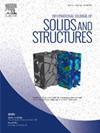Stability discussion and application study of pseudo-corner models
IF 3.4
3区 工程技术
Q1 MECHANICS
International Journal of Solids and Structures
Pub Date : 2024-11-13
DOI:10.1016/j.ijsolstr.2024.113136
引用次数: 0
Abstract
Accurate plastic flow modelling under complex working conditions is crucial for metal deformation simulations. Recently, some advanced pseudo-corner models have been developed to describe corner effects and analyze strain localization problems. The present work consists of three parts. The first part discusses the intrinsic stability of the pseudo-corner model class, which forms the premise of application analysis. The second part applies the pseudo-corner models and the associated flow rule (AFR) to buckling onset estimation, plastic post-buckling analysis and shear band analysis. The experimental conditions are strictly reproduced and the optimal model parameters are determined. The results reveal that the pseudo-corner models and AFR are indistinguishable in the buckling onset estimation. AFR overestimates the post-buckling strength of circular tubes under axial compression, and cannot reproduce the shear band development during sheet bending; while the pseudo-corner models have better prediction performance in both scenarios. The results also suggest that the parameter values of pseudo-corner models are apparently inconsistent in the above two types of problems. Then in the third part, two representative influencing factors including strain gradient plasticity and initial imperfections are discussed, and this inconsistency is finally attributed to the shortwave surface defect which however is usually neglected by previous studies.
伪角模型的稳定性讨论和应用研究
复杂工作条件下的精确塑性流动建模对于金属变形模拟至关重要。最近,人们开发了一些先进的伪转角模型来描述转角效应和分析应变定位问题。本研究包括三个部分。第一部分讨论了伪转角模型类的内在稳定性,这是应用分析的前提。第二部分将伪角模型和相关流动规则(AFR)应用于屈曲起始估计、屈曲后塑性分析和剪切带分析。严格再现了实验条件,并确定了最佳模型参数。结果表明,伪角模型和 AFR 在屈曲起始估计方面没有区别。AFR 高估了圆管在轴向压缩下的屈曲后强度,并且无法再现板材弯曲过程中的剪切带发展;而伪角模型在这两种情况下都具有更好的预测性能。结果还表明,在上述两类问题中,伪拐角模型的参数值明显不一致。第三部分讨论了两个具有代表性的影响因素,包括应变梯度塑性和初始缺陷,最后将这种不一致性归因于短波表面缺陷,然而之前的研究通常忽略了这一点。
本文章由计算机程序翻译,如有差异,请以英文原文为准。
求助全文
约1分钟内获得全文
求助全文
来源期刊
CiteScore
6.70
自引率
8.30%
发文量
405
审稿时长
70 days
期刊介绍:
The International Journal of Solids and Structures has as its objective the publication and dissemination of original research in Mechanics of Solids and Structures as a field of Applied Science and Engineering. It fosters thus the exchange of ideas among workers in different parts of the world and also among workers who emphasize different aspects of the foundations and applications of the field.
Standing as it does at the cross-roads of Materials Science, Life Sciences, Mathematics, Physics and Engineering Design, the Mechanics of Solids and Structures is experiencing considerable growth as a result of recent technological advances. The Journal, by providing an international medium of communication, is encouraging this growth and is encompassing all aspects of the field from the more classical problems of structural analysis to mechanics of solids continually interacting with other media and including fracture, flow, wave propagation, heat transfer, thermal effects in solids, optimum design methods, model analysis, structural topology and numerical techniques. Interest extends to both inorganic and organic solids and structures.

 求助内容:
求助内容: 应助结果提醒方式:
应助结果提醒方式:


